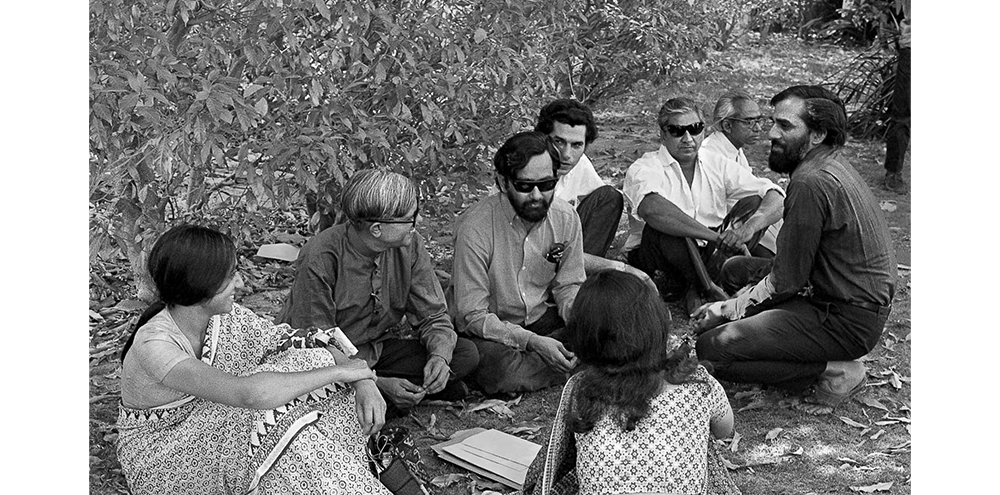Baroda as School and Center/Study of the Evolving Role of the Artist in India
The art scene in Baroda grew out of the Faculty of Fine Arts Department at the MS University of Baroda. The Department was established in 1949 just after independence, in the words of Gulammohammed Sheikh “with the objective of advancing technology and technical education, in conformity to the models of the day.” Like the JJ School of Art in Bombay, the school offered diplomas in individual subjects, but its objective was “combining practice and theory courses ‘so as to turn out a more skillful artisan than present.’” Uniquely, Baroda privileged education in the vernacular language — Gujarati — while also providing education in Western art history from the onset. One major difference from art and pedagogical trends in Bombay was a greater interest in engaging folk and traditional forms and an engagement with everyday visual culture, as opposed to framing art history and practice around colonial legacies and Euro-american modernism. Further, the university, and then the art scene, built a healthy symbiotic relationship with the city of Baroda through the school’s engagement with the seasonal cycle of festivals like the garba during Navratri. At the same time, in spite of their distinct approaches and communities, there was also a strong relationship between Baroda and Bombay, due to proximity and artists’ reliance on galleries and exhibition spaces in cosmopolitan Bombay.
Many developments in art and the role of the artist were centered in Baroda in the 1970s. In India, by the late 1960s, there had been a number of formal groups and associations like the Progressive Artists’ Group (established on the eve of independence in 1947 in Bombay) and Group 1890 (that spanned just 1962-63 in Delhi and Baroda), which had set precedents for how artists in India could produce and exhibit their works together. One way this evolved in the 1970s was a series of “group” exhibitions through which like-minded artists enacted social and political protest. These were largely against the national art organization Lalit Kala Akademi and broader government policies.
Artists, intellectuals, and many others were especially critical of the government in the period leading up to the Emergency from 1975-77, which gave Prime Minister Indira Gandhi power to rule by decree and suspend many civil liberties, including canceling elections. This coincided with a shift as artists and intellectuals, led largely by artist Vivan Sundaram and critic Geeta Kapur, who were between Delhi and Baroda, increasingly took on activist roles through their work challenging government corruption. Sundaram studied and worked in painting, exploring formalist approaches before deriding this as elite and expanding to additional activities and mediums. These included organizing a street exhibition of photographs of the Bangladesh War in 1971, holding a series of workshops to make art more accessible and affordable, and late founding of the Journal of Arts and Ideas in 1982 as an extension of these activities and his activism. Shows such as “Group Exhibition, 1974,” held at Rabindra Bhavan Galleries in New Delhi were accompanied by catalogs with political and polemical essays, most often by Kapur. In the essay for “Group Exhibition, 1974,” before turning to individual artists and works in the exhibition, Kapur writes pointedly about both the “corrupt and safe radicalism” of Indira Gandhi’s government and the issue of indigenism, which she describes as a “modernised version of tradition” and the preference of the “ruling class” at the time. She takes issue with both the idea of “fake Indianness” and art as commodity, and with safe formal approaches to art, instead voicing her support of art and artists who offer social commentary or an ideological perspective through wit, irony, anger, or compassion.
At the same time as Kapur, Sundaram, and others engaged art for explicitly political aims, the inimitable pioneering artist K.G. Subramanyan endeavored to create other public purposes and encounters for art through his position as professor and then as Dean of the Faculty of Fine Arts. Subramanyan sought to “strew art in the environment,” for instance through public murals at Jyoti Limited, while shaping the pedagogic goals and atmosphere of the college through the 1960s and 1970s, encouraging students to work in a variety of mediums as he did. He also led weekend lectures that spanned the role of the artist to how we observe the world and develop an artistic vision. Through Subramanyan, this was an era of “artist as teacher” in Baroda, with faculty including Nasreen Mohamedi, Gulam Sheikh, and others, many of whom had returned from abroad. Relationships between teacher and student in this period echoed the “guru-shishya” model, with education occurring as much in the classroom as in weekend lectures and at the college canteen.
Alongside education in studio art, the MS University’s Department of Art History distinguished itself in this period by examining itself in relation to studio practice and evaluating its traditional status in India, unlike earlier departments that were largely in the service of Indologists and archaeologists



